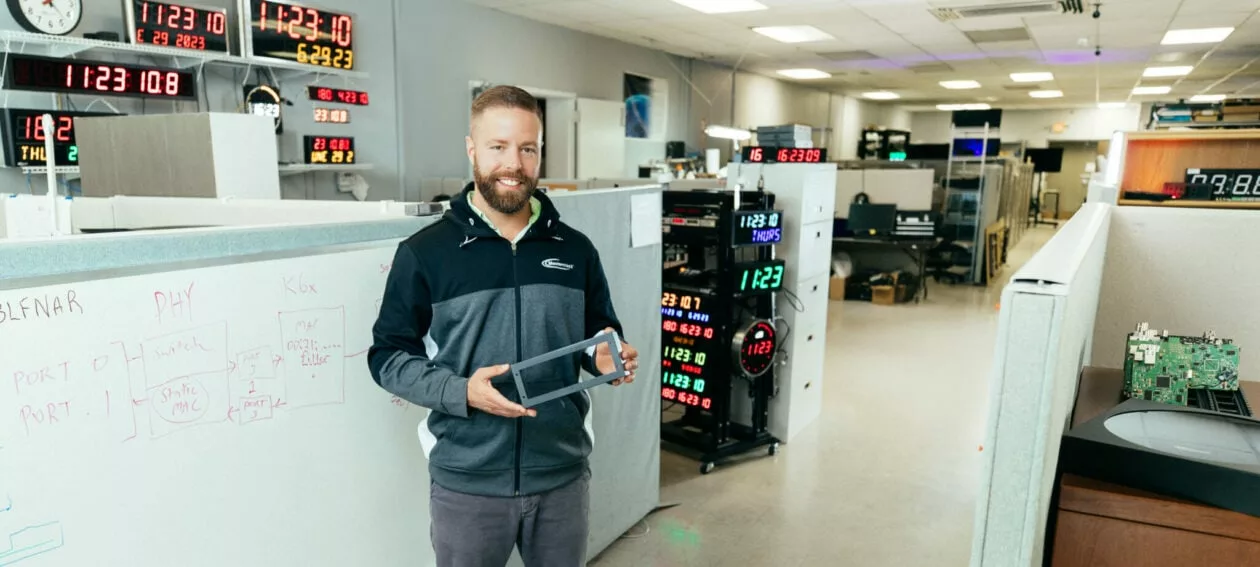It’s no secret that digital printing technology is changing the manufacturing industry. But for manufacturers that want to incorporate 3D printing, also known as additive manufacturing, the steepness of the learning curve complicates the process of making an informed investment. For smaller manufacturers, the challenge is even more acute.
Addressing that challenge is at the heart of a recent engineering analysis conducted by experts at Missouri University of Science and Technology on behalf of Masterclock, a manufacturer of precise timing systems equipment based in St. Charles, Missouri. Masterclock has 25 employees.
Dr. Richard Billo, director of the Kummer Center for Advanced Manufacturing at Missouri S&T, led the analysis. Assuming current market conditions, it found that the cost of equipment required to 3D print the casements that house the display clocks Masterclock manufactures outweighs the potential savings.
“We knew that 3D printing is definitely changing the manufacturing game,” says John Clark, Masterclock president and CEO. “But as a small business without an enormous R&D budget, without being knowledgeable about the market, we weren’t in a position to make huge bets on the equipment.”
Thanks to insight gleaned from S&T’s analysis, he doesn’t have to.
“I got a world-class, real-time review of how what’s on the market lines up with what we’d like to do at Masterclock,” says Clark. “I no longer have that voice in the back of my head, wondering if I’m missing out on the right investment.”
Billo says the work his team did with Masterclock is an example of S&T’s commitment to collaborating with manufacturers across Missouri to help them be more innovative and competitive in the global marketplace. That commitment is about to get a lot more tangible.
In October, S&T will break ground for the Missouri Protoplex, an advanced manufacturing research and development facility that will anchor the university’s planned manufacturing technology and innovation campus. In addition to providing space for equipment that will be available to manufacturers like Masterclock as well as S&T students and researchers, the facility will serve as a headquarters of sorts for the network Billo and others are building through partnerships with the Missouri Association of Manufacturers (MAM), the Society of Manufacturing Engineers (SME), and community colleges and tech schools across the state.
“The core of the Missouri Protoplex is S&T providing valuable resources to manufacturing businesses across the state,” Billo says.
But the benefits won’t stop there, he says. In addition to offering an opportunity for manufacturers to learn about new methods and technologies, Billo says the equipment housed in the Protoplex will help S&T students develop skills they’ll need when they join the workforce.
“There’s lots of apprehension around advanced manufacturing because there’s a skills shortage in the workforce,” he says. “Missouri S&T and the Missouri Protoplex are resources for these companies. We’re taking a collaborative approach, taking the time to understand what manufacturers really need rather than just telling them what courses we plan to offer.”
Billo and Clark met last February at a gathering of St. Charles-area manufacturers organized by the Partnership to Enhance Innovation, Resilience and Agility in Missouri’s Manufacturers to help manufacturing businesses address challenges heightened during the pandemic like worker shortages, inflation and supply chain disruptions. Offered through the University of Missouri Extension, the partnership provides Missouri manufacturers streamlined access to the expertise and resources of all four UM System universities.
When the two met, the digital printing market was exploding with possibilities, and Clark, like many manufacturers, was trying to determine if 3D printing was a cost-effective alternative to purchasing parts from suppliers.
“We wanted to explore the potential of additive manufacturing,” Clark says. “But we didn’t have access to the resources required to do that.”
Drawing on matching funds from an Economic Development Administration (EDA) grant, the analysis the Center for Advanced Manufacturing at S&T conducted on behalf of Masterclock was funded in part by the UM System Manufacturer Partnership.
“For most of our portfolio, it doesn’t make sense for an organization of our size to invest in the technology at this time,” Clark says. “But the analysis conducted by S&T did show us that many forms of 3D printing have reached the point that there’s parity or better, on a per-part basis, with fabricated parts.”
That represents a potentially major leap forward for a company the size of Masterclock. Digital printing, according to the analysis, could liberate small manufacturers from the large minimum quantity requirements that are a fact of doing business within the confines of the supply chain; the technology could enable small manufacturers like Masterclock a much higher measure of design freedom and manufacturing agility, making it possible, for example, for Clark and his team to take a more flexible approach to navigating changes in the design of aircraft for which the company supplies timekeeping equipment that keep the aircraft’s GPS functionality in synch with the satellites that guide it. 3D printing could also help the company reduce inventory.
In addition, thanks to processes like automated surface finishing, digital printing is beginning to look promising in terms of producing parts that are end-user grade.
All of which is good news for Clark, who finds himself contending with a supply chain that doesn’t deliver important parts as reliably as it once did.
“How can we eliminate the supply chain?” he asks as considers incorporating 3D printing at Masterclock. “How can we manufacture clocks more affordably?”
Subscribe to AM Chronicle Newsletter to stay connected: https://bit.ly/3fBZ1mP
Follow us on LinkedIn: https://bit.ly/3IjhrFq
Visit for more interesting content on additive manufacturing: https://amchronicle.com


